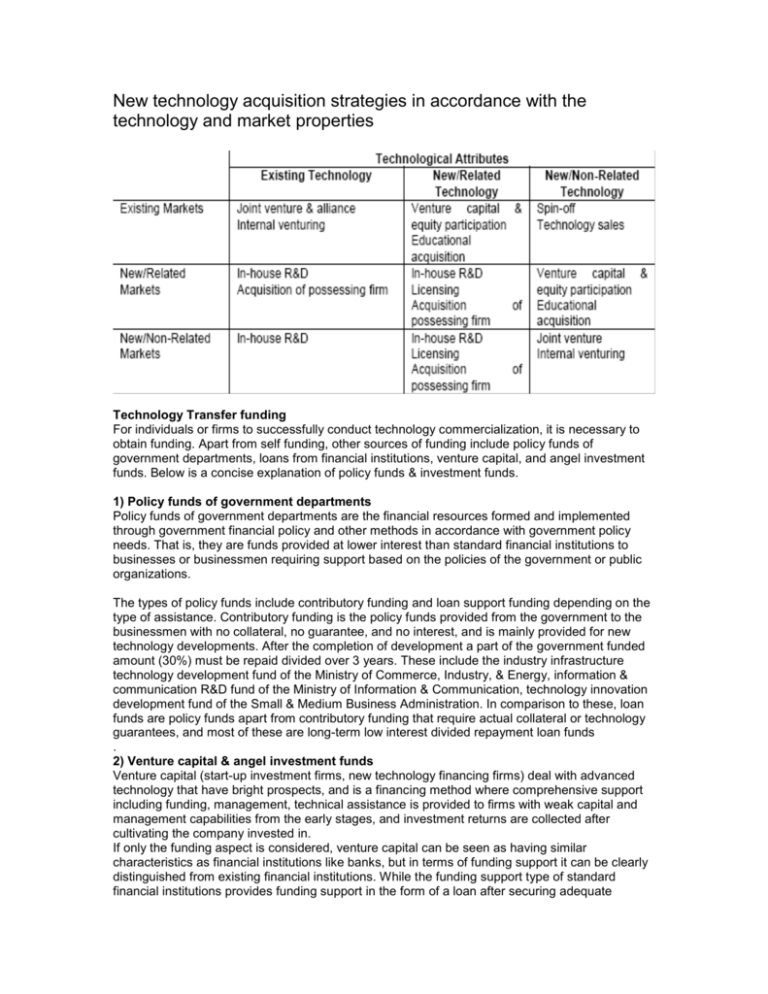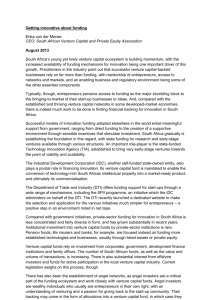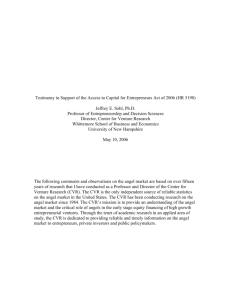New technology acquisition strategies in accordance with the
advertisement

New technology acquisition strategies in accordance with the technology and market properties Technology Transfer funding For individuals or firms to successfully conduct technology commercialization, it is necessary to obtain funding. Apart from self funding, other sources of funding include policy funds of government departments, loans from financial institutions, venture capital, and angel investment funds. Below is a concise explanation of policy funds & investment funds. 1) Policy funds of government departments Policy funds of government departments are the financial resources formed and implemented through government financial policy and other methods in accordance with government policy needs. That is, they are funds provided at lower interest than standard financial institutions to businesses or businessmen requiring support based on the policies of the government or public organizations. The types of policy funds include contributory funding and loan support funding depending on the type of assistance. Contributory funding is the policy funds provided from the government to the businessmen with no collateral, no guarantee, and no interest, and is mainly provided for new technology developments. After the completion of development a part of the government funded amount (30%) must be repaid divided over 3 years. These include the industry infrastructure technology development fund of the Ministry of Commerce, Industry, & Energy, information & communication R&D fund of the Ministry of Information & Communication, technology innovation development fund of the Small & Medium Business Administration. In comparison to these, loan funds are policy funds apart from contributory funding that require actual collateral or technology guarantees, and most of these are long-term low interest divided repayment loan funds . 2) Venture capital & angel investment funds Venture capital (start-up investment firms, new technology financing firms) deal with advanced technology that have bright prospects, and is a financing method where comprehensive support including funding, management, technical assistance is provided to firms with weak capital and management capabilities from the early stages, and investment returns are collected after cultivating the company invested in. If only the funding aspect is considered, venture capital can be seen as having similar characteristics as financial institutions like banks, but in terms of funding support it can be clearly distinguished from existing financial institutions. While the funding support type of standard financial institutions provides funding support in the form of a loan after securing adequate collateral and charges a predetermined interest, venture capital is funding in the form of unsecured share investments to ventures that have technology but are weak in terms of collateral, and when the venture grows & develops, return on investments are collected by the sale of shares. These differences can be classified in terms of risk and returns, and if a specified interest is guaranteed to standard financial institutions while not bearing the risk of success & failure with adequate collateral, venture capital can obtain many times more in terms of return in accordance with the management results of the venture enterprise, but there are cases where no returns can be collected on the investment. As a result, even if capital or collateral is inadequate, if there is suitable technology and potential for growth, support can be gained from venture capital firms and not only cane they establish business but they can also obtain a high feeling of accomplishment. Venture capital investment acquisition procedure Business outline submission Consultation Preliminary examination Main assessment Investment contract Investment Management technology support Telephone Direct visitation Outline examination of planned business Main assessment decision Examination of management capability, business technology, management Investment assessment (Investment decision committee) Investment contract negotiation & contract signing Investment in accordance with contract details Financial, management, technology support to assist the growth of the firm after investment Angel investment Angel investment involves individual investors who appear like angels providing funds required in the early stages of company establishment. This involves the provision of required funding, management advice etc. for venture enterprises facing difficulties in raising funds after establishment, and the lead angel and support angel are the main constituents. The lead angel is usually in his 50s who has succeeded and retired as a manager and takes on a leading role in the support of the venture enterprise, and he/she possesses abundant capital, management experience, and technology evaluation ability, at times participating as a part-time director. The support angel is usually a person in a specialized field such as lawyers, accountants, consultants etc. who supports the entrepreneur with expert knowledge or an acquaintance of the venture enterprise. Indirectsupport is provided and at times private funds are also invested Comparison between angel investment & venture capital Future of TT Most important, there is a growing recognition within academia and industry that university technology transfer efforts afford significant opportunities to many communities: To the university, technology transfer gives the academic community the opportunity to have a positive impact on the marketplace, products and economic impact To the industrial community, technology transfer gives the private, for-profit sector the means to tap the very significant world of new discovery found in the academic laboratory To the public at large, technology transfer provides the opportunity to benefit from extraordinary new advances being made by the brightest minds Why is an agreement required for material transfer? Most providers of material will want to have an MTA in place so that there is a common understanding of how the materials can be used. More importantly, both parties involved in the exchange of research materials will benefit from the arrangement. Informal transfers done without MTAs offer little protection on either the provider or the recipient. An MTA establishes ownership to any potential inventions which may be developed by the use of the materials. Also, if the material to be transferred includes material that is still owned by a third party provider, further transfer of that material is almost certainly contractually restricted by the MTA and can provoke litigation. However, it is often possible to transfer the material, if the new recipient agrees to honor the obligations imposed by the original provider by entering into an MTA. In order to provide you with timely service, we ask that you complete the Material Transfer Request form to expedite your request. This assists our office in preparing an accurate evaluation of the particular MTA agreement and proposing appropriate terms and conditions, if necessary. The information received on the request form can minimize the delay in the approval of the agreement. Every MTA is different, the materials being transferred, in or out, all have specific properties, specific risks and specific applications.









![Chapter 3 – Idea Generation [ENK]](http://s3.studylib.net/store/data/007787902_2-04482caa07789f8c953d1e8806ef5b0b-300x300.png)
